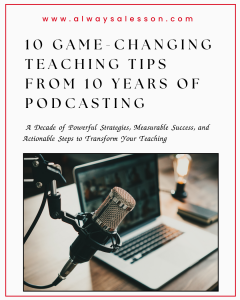Creating a Strong Math Culture at your School [Part One]
How would you rate the math culture at your school on a scale from 1-10 (1 being poor and 10 being excellent)? Are teachers confident at teaching math? Are students excelling in math?
 I recently lead a discussion on creating a strong math culture at your school on the Clubhouse app under the Instructional Coaching Club. Over 20 educators (classroom teachers, administrators, school board members, instructional coaches, and content area specialists) came together to share ideas and ask questions.
I recently lead a discussion on creating a strong math culture at your school on the Clubhouse app under the Instructional Coaching Club. Over 20 educators (classroom teachers, administrators, school board members, instructional coaches, and content area specialists) came together to share ideas and ask questions.
The power of social media to connect educators in real time while providing timely professional development is an outstanding, underutilized tool.
Since this was such an empowering discussion, I decided to share my takeaways here on the blog. This is a three-part post on increasing math culture in your school building (part two and part three).
Today’s question is:
How can you tell if your teachers or school value math?
Time Study
Rating your school on a 1-10 scale might be hard if you’re not sure what to look for as evidence of math culture. Conducting a time study is a good first step. Simply write down what content areas are taught and how long each learning session lasts per subject. This will bring clarity. Wherever time is most allocated is where there is a priority. Is it the content area of math? If not, redo your schedule so more time can be devoted to math instruction.
Available Materials
Do a materials inventory to take stock of all math manipulatives or other instructional materials available in the building or teachers’ classrooms. First, make note of missing or broken materials for replacement. Second, calibrate teachers’ supplies so that they have identical sets. Lastly, make a list of additional supplies you would like to purchase or have donated. Having numerous learning supports is a beginning step to increasing the value of math in your building.
Modeling
Walk through classrooms to get an idea of how much teacher modeling is happening during math instruction. What percent of the time is spent modeling mathematical concepts during a typical math block? This could be demonstrating problem solving, formulas and processes, referencing past knowledge etc. As a leadership team, decide the ideal percent of a lesson that should be dedicated to modeling or demonstration for your building. Then, average the percent of time teachers spent modeling during an entire lesson of all the classrooms visited. Lastly, develop a plan for increasing that percentage if it is below your ideal number. Modeling math thinking for teachers is a great way for them to feel comfortable modeling in their own classrooms.
Planning Habits
Attend planning periods to get an idea of how teachers plan their math instruction. Are they focused on developing strategic questions to uncover student misunderstandings or are they simply noting page numbers and topics in a planner? How we think about teaching is often how we end up delivering instruction. If we think at low levels we will deliver at low levels. To break the bad habit of planning pages and topics to cover, provide teachers with sentence stems to aid in deeper collaboration. Focus on breaking standards down into objectives, student work exemplars, differentiated structure, etc. Use this resource to guide you,
Evidence
Walk the halls of the school. Look at student work samples in classrooms. Are students simply memorizing math facts and being tested on their fluency? Or are they presented with rich problems to solve? Are students doing a lot of math talk or is the teacher dominating the conversation? We want students to fully utilize math language. We must help them recognize vocabulary, begin to use it correctly and then showcase it fluently. This continuum is similar to learning a new language, the more you immerse yourself in it, the more it becomes part of your vernacular. If you cannot find much evidence, decide what evidence you want to see among grade levels and prioritize that during the math instructional planning phase.
Suggested Resources for Building Math Culture:
- Math Tools & Activities
- Mathematical Mindsets by Jo Boaler
- Elementary and Middle School Mathematics (Teaching Developmentally) by Karen Karp
If you found this post helpful, be sure to check out the second and third post in the series (coming soon).
Go Be Great!
What action will you take to create a stronger math culture in your building?


